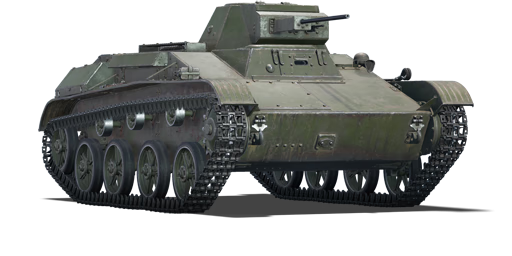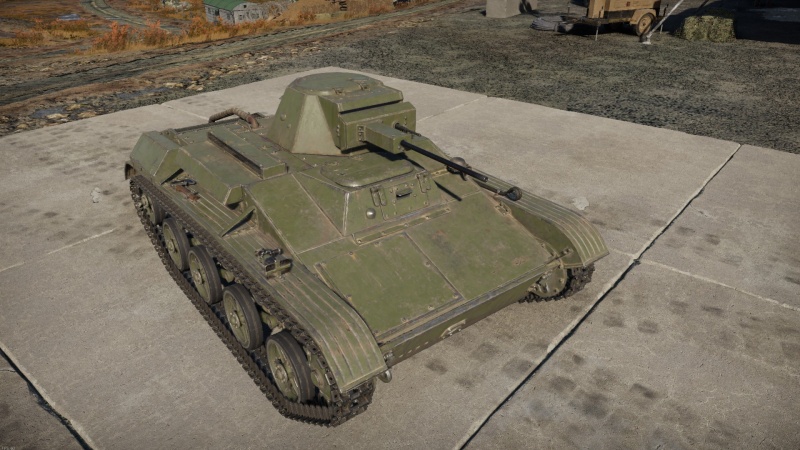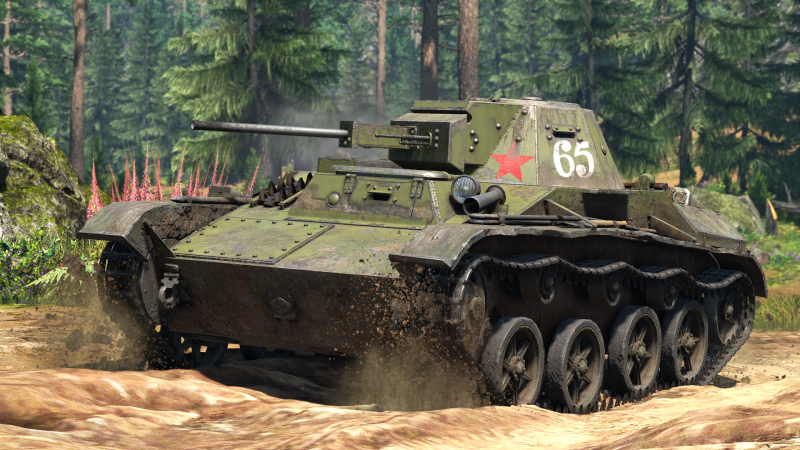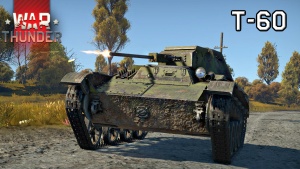Difference between revisions of "T-60"
Colok76286 (talk | contribs) (→Mobility: Updated to new mobility template) |
(→Description) |
||
| (25 intermediate revisions by 9 users not shown) | |||
| Line 1: | Line 1: | ||
| − | {{Specs-Card|code=ussr_t_60_1941}} | + | {{Specs-Card |
| + | |code=ussr_t_60_1941 | ||
| + | |images={{Specs-Card-Image|GarageImage_{{PAGENAME}}.jpg|ArtImage_{{PAGENAME}}.png}} | ||
| + | }} | ||
== Description == | == Description == | ||
<!-- ''In the description, the first part should be about the history of the creation and combat usage of the vehicle, as well as its key features. In the second part, tell the reader about the ground vehicle in the game. Insert a screenshot of the vehicle, so that if the novice player does not remember the vehicle by name, he will immediately understand what kind of vehicle the article is talking about.'' --> | <!-- ''In the description, the first part should be about the history of the creation and combat usage of the vehicle, as well as its key features. In the second part, tell the reader about the ground vehicle in the game. Insert a screenshot of the vehicle, so that if the novice player does not remember the vehicle by name, he will immediately understand what kind of vehicle the article is talking about.'' --> | ||
| − | + | The '''{{Specs|name}}''' was a Soviet light tank, developed in the late 1930s as a replacement for the amphibious T-38 scout tank. The team around designer Nicholas Astrov started designing the tank at Moscow Factory No. 37 in 1938, and two prototypes designated T-38A and T-38B were produced. The former was manufactured from 1940 as the T-40 light amphibious tank. The T-60 was considered a stop-gap tank after the German attack on the Soviet Union, until factories could produce enough T-34s and KV tanks. The T-60 used the chassis from the T-40 but gave up its ability to float for thicker armour. The T-60 was initially to be armed with a 12.7 mm DShK machine gun, but the army demanded stronger armament, so a 20 mm TNSh cannon was chosen instead. The TNSh was a tank version of the aircraft ShVAK cannon and, as such, had very low penetration characteristics, being able to penetrate only 15 mm of armour at 500 m. Such gun characteristics were not enough to engage newer, up-armoured German tanks, so the T-60 was moved into the role of an infantry support tank. The T-60 served as a base for an upgunned and uparmoured version which would later become the [[T-70]] tank. The T-60 served through the entire war, and Romania modified 34 captured T-60s into their domestic TACAM T-60 tank destroyer. | |
| − | + | ||
| − | The '''{{Specs|name}}''' | + | The T-60 was introduced during the Closed Beta Test for Ground Forces before Update 1.41. Thanks to the combination of a mobile chassis and strong, sloped frontal armour, the T-60 is well suited for combat according to almost any tactic. The gun, however, suffers from very poor ballistic properties and struggles to penetrate most opponents frontally, so flanking is advised while utilising the T-60. Additionally, it features a very long reload once each relatively small magazine is expended. |
== General info == | == General info == | ||
=== Survivability and armour === | === Survivability and armour === | ||
| + | {{Specs-Tank-Armour}} | ||
<!-- ''Describe armour protection. Note the most well protected and key weak areas. Appreciate the layout of modules as well as the number and location of crew members. Is the level of armour protection sufficient, is the placement of modules helpful for survival in combat? If necessary use a visual template to indicate the most secure and weak zones of the armour.'' --> | <!-- ''Describe armour protection. Note the most well protected and key weak areas. Appreciate the layout of modules as well as the number and location of crew members. Is the level of armour protection sufficient, is the placement of modules helpful for survival in combat? If necessary use a visual template to indicate the most secure and weak zones of the armour.'' --> | ||
| + | [[File:T60 Screenshot 3.jpg|thumb|T-60 on "[[Frozen Pass (Ground Forces)|Frozen Pass]]"]] | ||
| + | The armour of the T-60 is fairly effective frontally, being for the most part angled gives it good protection against similarly rated opponents with a high chance of causing shots to ricochet, however a shot to the side will likely be fatal due to the thin (15 mm) side armour and the vehicle only having a 2 man crew, this means that the loss of 1 crew member will cause the vehicle to be knocked out. | ||
| + | |||
'''Armour type:''' | '''Armour type:''' | ||
| + | |||
* Rolled homogeneous armour | * Rolled homogeneous armour | ||
| + | |||
{| class="wikitable" | {| class="wikitable" | ||
|- | |- | ||
! Armour !! Front !! Sides !! Rear !! Roof | ! Armour !! Front !! Sides !! Rear !! Roof | ||
|- | |- | ||
| − | | Hull || 35 mm ( | + | | Hull || 35 mm (24°) ''Driver's plate'' <br> 15 mm (70°) ''Front glacis'' <br> 35 mm (31°) ''Lower glacis'' || 15 mm || 10 mm (71°) ''Top'' <br> 5 mm (71°) ''Radiator vent'' <br> 25 mm (29°) ''Bottom'' || 15 mm (20°) ''Front glacis'' <br> 20 mm ''Driver hatch'' <br> 15 mm <br> 5 mm ''Engine vent'' <br> 10 mm (19°) ''Rear'' <br> 5 mm (19°) ''Radiator vent'' |
|- | |- | ||
| − | | Turret || 25 mm ( | + | | Turret || 25 mm (24°) ''Turret front'' <br> 35 mm ''Gun mantlet''|| 25 mm (24-26°) || 25 mm (26°) || 10 mm ''Turret'' <br> 20 mm ''Cupola'' |
|} | |} | ||
'''Notes:''' | '''Notes:''' | ||
| + | |||
* Belly armour is 10 mm thick. | * Belly armour is 10 mm thick. | ||
| − | * Suspension wheels are 10 mm thick while tracks are 15 mm thick. | + | * Suspension wheels are 10 mm thick while tracks and torsion bars are 15 mm thick. |
=== Mobility === | === Mobility === | ||
| + | {{Specs-Tank-Mobility}} | ||
<!-- ''Write about the mobility of the ground vehicle. Estimate the specific power and manoeuvrability, as well as the maximum speed forwards and backwards.'' --> | <!-- ''Write about the mobility of the ground vehicle. Estimate the specific power and manoeuvrability, as well as the maximum speed forwards and backwards.'' --> | ||
| − | {{tankMobility|abMinHp= 118|rbMinHp= 67| | + | {{tankMobility|abMinHp=118|rbMinHp=67}} |
| + | |||
| + | The mobility of the T-60 is very comparable to the T-26, while it is fast enough to move around the map with ease, it is not mobile enough to be the first friendly to the cap or camping position, the mobility is enough to allow for a support or flanking role in most situations. | ||
| + | |||
| + | [[File:T-60 Screenshot 2.jpg|thumb|T-60 firing its 20 mm cannon]] | ||
| + | |||
| + | === Modifications and economy === | ||
| + | {{Specs-Economy}} | ||
== Armaments == | == Armaments == | ||
| + | {{Specs-Tank-Armaments}} | ||
=== Main armament === | === Main armament === | ||
| + | {{Specs-Tank-Weapon|1}} | ||
<!-- ''Give the reader information about the characteristics of the main gun. Assess its effectiveness in a battle based on the reloading speed, ballistics and the power of shells. Do not forget about the flexibility of the fire, that is how quickly the cannon can be aimed at the target, open fire on it and aim at another enemy. Add a link to the main article on the gun: <code><nowiki>{{main|Name of the weapon}}</nowiki></code>. Describe in general terms the ammunition available for the main gun. Give advice on how to use them and how to fill the ammunition storage.'' --> | <!-- ''Give the reader information about the characteristics of the main gun. Assess its effectiveness in a battle based on the reloading speed, ballistics and the power of shells. Do not forget about the flexibility of the fire, that is how quickly the cannon can be aimed at the target, open fire on it and aim at another enemy. Add a link to the main article on the gun: <code><nowiki>{{main|Name of the weapon}}</nowiki></code>. Describe in general terms the ammunition available for the main gun. Give advice on how to use them and how to fill the ammunition storage.'' --> | ||
{{main|TNSh (20 mm)}} | {{main|TNSh (20 mm)}} | ||
| + | |||
| + | The main armament of the T-60 is a 20 mm TNSh cannon, this has a fire rate of 750 rounds/min and will have to reload after 58 rounds have been fired, the gun is certainly effective against lightly armoured opponents but will have trouble against higher-rated heavy and medium tanks. | ||
{| class="wikitable" style="text-align:center" width="100%" | {| class="wikitable" style="text-align:center" width="100%" | ||
|- | |- | ||
| − | ! colspan=" | + | ! colspan="6" | [[TNSh (20 mm)|20 mm TNSh]] || colspan="5" | Turret rotation speed (°/s) || colspan="4" | Reloading rate (seconds) |
|- | |- | ||
| − | ! Mode !! Capacity !! Vertical !! Horizontal !! Stabilizer | + | ! Mode !! Capacity (Belt) !! Fire rate !! Vertical !! Horizontal !! Stabilizer |
! Stock !! Upgraded !! Full !! Expert !! Aced | ! Stock !! Upgraded !! Full !! Expert !! Aced | ||
! Stock !! Full !! Expert !! Aced | ! Stock !! Full !! Expert !! Aced | ||
|- | |- | ||
! ''Arcade'' | ! ''Arcade'' | ||
| − | | rowspan="2" | 754 || rowspan="2" | -7°/+25° || rowspan="2" | ±180° || rowspan="2" | N/A || 14. | + | | rowspan="2" | 754 (58) || rowspan="2" | 750 || rowspan="2" | -7°/+25° || rowspan="2" | ±180° || rowspan="2" | N/A || 14.30 || 19.76 || 24.00 || 26.54 || 28.24 || rowspan="2" | 26.00 || rowspan="2" | 23.00 || rowspan="2" | 21.20 || rowspan="2" | 20.00 |
|- | |- | ||
! ''Realistic'' | ! ''Realistic'' | ||
| − | | 8. | + | | 8.93 || 10.50 || 12.75 || 14.10 || 15.00 |
|- | |- | ||
|} | |} | ||
==== Ammunition ==== | ==== Ammunition ==== | ||
| − | {| | + | |
| − | + | * '''Default:''' {{Annotation|AP-I|Armour-piercing incendiary}}{{-}}{{Annotation|FI|Fragmentation incendiary}} - The default belt is the most effective against aircraft because of the presence of 1/2 FI shells, which can make quick work of any aerial threats. Its performance against ground vehicles is however lessened by that. | |
| − | |- | + | * '''API:''' {{Annotation|AP-I|Armour-piercing incendiary}}- This belt fixes the default belt's problem against ground vehicles, and allows you to have AP-I shells only. However, this reduces performance against aircraft. |
| − | + | * '''API HV:''' {{Annotation|AP-I|Armour-piercing incendiary}}{{-}}{{Annotation|AP-I|Armour-piercing incendiary}}{{-}}{{Annotation|FI|Fragmentation incendiary}}- This belt could be considered the best out of the three, as it has improved AP-I shells with a couple more millimetres of penetration. Additionally, the 1/3 FI shell presence helps with air defense quite a bit, but doesn't worsen your damage against ground vehicles as much as the default belt does. | |
| − | + | ||
| − | |- | + | {{:TNSh (20 mm)/Ammunition|FI, API, API HV}} |
| − | |||
| − | |- | ||
| − | |||
| − | |- | ||
| − | | | ||
| − | |||
| − | |||
| − | {| | ||
| − | |||
| − | |- | ||
| − | |||
| − | |||
| − | |||
| − | |||
| − | |||
| − | |||
| − | |||
| − | |||
| − | |- | ||
| − | |||
| − | |||
| − | |||
| − | |||
| − | | FI | ||
| − | |||
| − | |||
==== [[Ammo racks]] ==== | ==== [[Ammo racks]] ==== | ||
| − | + | [[File:Ammoracks_{{PAGENAME}}.jpg|right|thumb|x250px|[[Ammo racks]] of the {{PAGENAME}}]] | |
| + | <!-- '''Last updated:''' --> | ||
{| class="wikitable" style="text-align:center" | {| class="wikitable" style="text-align:center" | ||
|- | |- | ||
| Line 92: | Line 89: | ||
! 2nd<br>rack empty | ! 2nd<br>rack empty | ||
! 3rd<br>rack empty | ! 3rd<br>rack empty | ||
| − | |||
| − | |||
| − | |||
! Visual<br>discrepancy | ! Visual<br>discrepancy | ||
|- | |- | ||
| − | | | + | | 13 || 9 ''(+4)'' || 5 ''(+8)'' || 1 ''(+12)'' || Yes |
|- | |- | ||
|} | |} | ||
| + | '''Note''': | ||
| − | + | * 1 clip contains 58 rounds. | |
| − | |||
| − | |||
| − | |||
| − | |||
| − | |||
| − | |||
| − | |||
| − | |||
| − | |||
| − | |||
| − | |||
| − | |||
| − | |||
| − | |||
=== Machine guns === | === Machine guns === | ||
| + | {{Specs-Tank-Weapon|2}} | ||
<!-- ''Offensive and anti-aircraft machine guns not only allow you to fight some aircraft but also are effective against lightly armoured vehicles. Evaluate machine guns and give recommendations on its use.'' --> | <!-- ''Offensive and anti-aircraft machine guns not only allow you to fight some aircraft but also are effective against lightly armoured vehicles. Evaluate machine guns and give recommendations on its use.'' --> | ||
{{main|DT (7.62 mm)}} | {{main|DT (7.62 mm)}} | ||
| − | {| class="wikitable" style="text-align:center" | + | {| class="wikitable" style="text-align:center" width="50%" |
|- | |- | ||
! colspan="5" | [[DT (7.62 mm)|7.62 mm DT]] | ! colspan="5" | [[DT (7.62 mm)|7.62 mm DT]] | ||
|- | |- | ||
| − | ! Mount | + | ! Mount !! Capacity (Belt) !! Fire rate !! Vertical !! Horizontal |
| − | ! Capacity | ||
| − | ! | ||
| − | ! Vertical | ||
| − | ! Horizontal | ||
|- | |- | ||
| Coaxial || 945 (63) || 600 || N/A || N/A | | Coaxial || 945 (63) || 600 || N/A || N/A | ||
| Line 137: | Line 115: | ||
== Usage in battles == | == Usage in battles == | ||
<!-- ''Describe the tactics of playing in the vehicle, the features of using vehicles in the team and advice on tactics. Refrain from creating a "guide" - do not impose a single point of view but instead give the reader food for thought. Describe the most dangerous enemies and give recommendations on fighting them. If necessary, note the specifics of the game in different modes (AB, RB, SB).'' --> | <!-- ''Describe the tactics of playing in the vehicle, the features of using vehicles in the team and advice on tactics. Refrain from creating a "guide" - do not impose a single point of view but instead give the reader food for thought. Describe the most dangerous enemies and give recommendations on fighting them. If necessary, note the specifics of the game in different modes (AB, RB, SB).'' --> | ||
| + | [[File:T-60 Screenshot 1.jpg|thumb|T-60 driving through "[[Eastern Europe (Ground Forces)|Eastern Europe]]" ]] | ||
The T-60 is a fine little tank that excels in very particular situations; namely holding corners, flanking, and acting as a close range SPAA. This tank should never be used for long-range shooting or in pushes against an enemy head-on, one should always try to use its speed and manoeuvrability to gain an advantage before attacking. In a [[:Category:Anti-aircraft vehicles|SPAA]] role, the long reload time for this tank's main weapon can be a severe disadvantage. This means that one should use controlled bursts when attacking aeroplanes, making all shots count, and only picking large slow moving targets when at the range. The presence of a co-axial machine gun, however, not only adds to the firing density but allows for the tank to fire whilst the cannon is reloading. This machine gun has no utility against armoured targets. In this role, the T-60 is the only SPAA in this rank that does not have to fear 7.7 mm rounds (although 12.7 mm rounds can be very deadly - the [[M2A2]] is a very dangerous opponent, for instance). This means that T-60 pilots can be confident that they can survive being strafed by most fighter aircraft. In RB this tank serves as a perfectly capable replacement for the [[GAZ-AAA (4M)|4M GAZ-AAA]]. In conclusion, the T-60 is a versatile tank of good effectiveness that is a constant presence of any Rank I ground forces game. Its gun gives it easy penetration at the sides and some fronts of low-rank tanks. | The T-60 is a fine little tank that excels in very particular situations; namely holding corners, flanking, and acting as a close range SPAA. This tank should never be used for long-range shooting or in pushes against an enemy head-on, one should always try to use its speed and manoeuvrability to gain an advantage before attacking. In a [[:Category:Anti-aircraft vehicles|SPAA]] role, the long reload time for this tank's main weapon can be a severe disadvantage. This means that one should use controlled bursts when attacking aeroplanes, making all shots count, and only picking large slow moving targets when at the range. The presence of a co-axial machine gun, however, not only adds to the firing density but allows for the tank to fire whilst the cannon is reloading. This machine gun has no utility against armoured targets. In this role, the T-60 is the only SPAA in this rank that does not have to fear 7.7 mm rounds (although 12.7 mm rounds can be very deadly - the [[M2A2]] is a very dangerous opponent, for instance). This means that T-60 pilots can be confident that they can survive being strafed by most fighter aircraft. In RB this tank serves as a perfectly capable replacement for the [[GAZ-AAA (4M)|4M GAZ-AAA]]. In conclusion, the T-60 is a versatile tank of good effectiveness that is a constant presence of any Rank I ground forces game. Its gun gives it easy penetration at the sides and some fronts of low-rank tanks. | ||
This is a very versatile tank and that is its greatest strength. Its greatest weakness is it's horrible all around armour, always remember that you will probably not survive a single hit from an AT gun, and as such stay hidden and behind cover. In order to accomplish this use, this tanks great manoeuvrability to your advantage and try to hug cover and move in depressions of the landscape. When using this tank always attack from an unexpected angle then shot your entire belt and afterwards '''always re-position after an attack'''. A great strength of this tank is that at any point it can go from flanking an enemy tank to acting as a front line SPAA, and in many games this amazing ability that can save you and your comrades from certain death at the hands of an enemy bomber or attack plane. | This is a very versatile tank and that is its greatest strength. Its greatest weakness is it's horrible all around armour, always remember that you will probably not survive a single hit from an AT gun, and as such stay hidden and behind cover. In order to accomplish this use, this tanks great manoeuvrability to your advantage and try to hug cover and move in depressions of the landscape. When using this tank always attack from an unexpected angle then shot your entire belt and afterwards '''always re-position after an attack'''. A great strength of this tank is that at any point it can go from flanking an enemy tank to acting as a front line SPAA, and in many games this amazing ability that can save you and your comrades from certain death at the hands of an enemy bomber or attack plane. | ||
| − | |||
| − | |||
| − | |||
| − | |||
| − | |||
| − | |||
| − | |||
| − | |||
| − | |||
| − | |||
| − | |||
| − | |||
| − | |||
| − | |||
| − | |||
| − | |||
| − | |||
| − | |||
| − | |||
| − | |||
| − | |||
| − | |||
| − | |||
| − | |||
| − | |||
| − | |||
| − | |||
| − | |||
| − | |||
| − | |||
| − | |||
| − | |||
| − | |||
| − | |||
| − | |||
| − | |||
| − | |||
=== Pros and cons === | === Pros and cons === | ||
<!-- ''Summarise and briefly evaluate the vehicle in terms of its characteristics and combat effectiveness. Mark its pros and cons in a bulleted list. Try not to use more than 6 points for each of the characteristics. Avoid using categorical definitions such as "bad", "good" and the like - use substitutions with softer forms such as "inadequate" and "effective".'' --> | <!-- ''Summarise and briefly evaluate the vehicle in terms of its characteristics and combat effectiveness. Mark its pros and cons in a bulleted list. Try not to use more than 6 points for each of the characteristics. Avoid using categorical definitions such as "bad", "good" and the like - use substitutions with softer forms such as "inadequate" and "effective".'' --> | ||
| + | [[File:T-60 Screenshot 4.jpg|thumb|T-60 driving into "[[Eastern Europe (Ground Forces)|Eastern Europe]]"]] | ||
| + | '''Pros:''' | ||
| − | |||
* Sloped frontal armour | * Sloped frontal armour | ||
* Fast-firing gun, that can even harm aircraft due to calibre and rate of fire | * Fast-firing gun, that can even harm aircraft due to calibre and rate of fire | ||
| Line 189: | Line 132: | ||
* Low profile | * Low profile | ||
* Often not regarded as a high priority target | * Often not regarded as a high priority target | ||
| − | |||
'''Cons:''' | '''Cons:''' | ||
| + | |||
* Poor armour | * Poor armour | ||
* Very cramped interior | * Very cramped interior | ||
| − | * Only 2 crew so you can't | + | * Only 2 crew so you can't afford losing anyone |
* Long reload time | * Long reload time | ||
* Very slow at climbing hills | * Very slow at climbing hills | ||
| Line 206: | Line 149: | ||
In 1938, a task to create an amphibious and non-amphibious scout tank was given to Nicholas Astrov's design team at Moscow Factory No. 37. The result was the T-30A and T-30B prototypes, with the A model being amphibious. The T-30A went on to become the T-40 amphibious scout tank, while the T-30B went on to become the '''T-60''' scout tank. Production started on July 1941, one month after the German invasion in Operation Barbarossa. | In 1938, a task to create an amphibious and non-amphibious scout tank was given to Nicholas Astrov's design team at Moscow Factory No. 37. The result was the T-30A and T-30B prototypes, with the A model being amphibious. The T-30A went on to become the T-40 amphibious scout tank, while the T-30B went on to become the '''T-60''' scout tank. Production started on July 1941, one month after the German invasion in Operation Barbarossa. | ||
| − | Originally with a 12.7 mm machine gun, the T-60 was up-gunned with a 20 mm TNSh cannon, which was derived from an aircraft cannon. The gun could penetrate 15 mm of armour at a 500 | + | Originally with a 12.7 mm machine gun, the T-60 was up-gunned with a 20 mm TNSh cannon, which was derived from an aircraft cannon. The gun could penetrate 15 mm of armour at a 500 m range, which proved very inadequate against the Germans [[Pz.III F|Panzer IIIs]] and [[Pz.IV F1|Panzer IVs]], which had a maximum of 50 mm of armour on the front. Not only that, the scout tank had poor mobility on cross-country terrain and had a maximum armour of only 20 mm thick. Despite that, the T-60 was easily produced and 6,292 of these tanks were produced between 1941 and 1942. |
===Usage=== | ===Usage=== | ||
| − | The low gun performance urged for an attempt to upgrade the tank with a 37 mm ZIS-19 cannon or the standard | + | The low gun performance urged for an attempt to upgrade the tank with a 37 mm ZIS-19 cannon or the standard 45 mm tank gun. Both of these projects were proven impossible. The T-60 served as a light tank up until the better [[T-70]] light tank was chosen as the new standard Soviet light tank in 1942, which had better armour and gun. |
The T-60 went on in armour developmental projects for the Soviet forces, such as the designing of the T-90 anti-aircraft vehicle. But perhaps the most unique project that it played in was the ''Antonov A-40'', which was the Soviet's attempt on a "flying tank". The A-40 was a glider design that has wings attached to a lightened T-60 (removing its armament, ammunition, some accessories, and most of the fuel). On September 2, 1942, in a test, the prototype was towed by a [[TB-3M-17-32|TB-3 Bomber]] into the air. When released, the A-40 reportedly glided smoothly on its descent, despite the drag it put on the TB-3 plane. The A-40 landed safely and was able to drive back to the testing site after detaching the wings. The project was then abandoned due to the lack of enough aircraft with the power to tow the A-40 at 160 kilometres per hour speed. | The T-60 went on in armour developmental projects for the Soviet forces, such as the designing of the T-90 anti-aircraft vehicle. But perhaps the most unique project that it played in was the ''Antonov A-40'', which was the Soviet's attempt on a "flying tank". The A-40 was a glider design that has wings attached to a lightened T-60 (removing its armament, ammunition, some accessories, and most of the fuel). On September 2, 1942, in a test, the prototype was towed by a [[TB-3M-17-32|TB-3 Bomber]] into the air. When released, the A-40 reportedly glided smoothly on its descent, despite the drag it put on the TB-3 plane. The A-40 landed safely and was able to drive back to the testing site after detaching the wings. The project was then abandoned due to the lack of enough aircraft with the power to tow the A-40 at 160 kilometres per hour speed. | ||
| Line 215: | Line 158: | ||
The T-60 also were used by the Romanians when they captured 34 of them and modified them into the TACAM T-60 and Mareşal M05, both tank destroyers. All examples of these vehicles were confiscated by the Soviets after Romania switched to the Allies. | The T-60 also were used by the Romanians when they captured 34 of them and modified them into the TACAM T-60 and Mareşal M05, both tank destroyers. All examples of these vehicles were confiscated by the Soviets after Romania switched to the Allies. | ||
| − | + | {{break}} | |
| + | {{Navigation-Start|{{Annotation|Archive of the in-game description|An archive of the historical description of the vehicle that was presented in-game prior to Update 1.55 'Royal Armour'}}}} | ||
| + | {{Navigation-First-Simple-Line}} | ||
The T-60 light tank was developed in August, 1941 at Moscow Factory #37 under the management of N.A. Astrov. In September, 1941 the T-60 was accepted into the arsenal of the Red Army and was released serially in several automobile factories. The T-60 was produced until February, 1943, when it was replaced on assembly lines by the more powerful T-70 light tank. A total of 5,920 T-60s were produced, 1,366 of them in 1941. Most of them were built at the Gorky Factory. | The T-60 light tank was developed in August, 1941 at Moscow Factory #37 under the management of N.A. Astrov. In September, 1941 the T-60 was accepted into the arsenal of the Red Army and was released serially in several automobile factories. The T-60 was produced until February, 1943, when it was replaced on assembly lines by the more powerful T-70 light tank. A total of 5,920 T-60s were produced, 1,366 of them in 1941. Most of them were built at the Gorky Factory. | ||
Large numbers of T-60 tanks were used in battles from 1941 to 1943, starting with the Battle of Moscow and ending with the elimination of the Leningrad blockade in January, 1944. The T-60 was used actively throughout the Battle of Stalingrad and the Kharkov Operation. Due to significant losses, the T-60 was gradually removed from the front lines in late 1942. | Large numbers of T-60 tanks were used in battles from 1941 to 1943, starting with the Battle of Moscow and ending with the elimination of the Leningrad blockade in January, 1944. The T-60 was used actively throughout the Battle of Stalingrad and the Kharkov Operation. Due to significant losses, the T-60 was gradually removed from the front lines in late 1942. | ||
| + | {{Navigation-End}} | ||
== Media == | == Media == | ||
| − | ''Excellent additions to the article would be video guides, screenshots from the game, and photos.'' | + | <!-- ''Excellent additions to the article would be video guides, screenshots from the game, and photos.'' --> |
| + | |||
| + | ;Skins | ||
| + | |||
| + | * [https://live.warthunder.com/feed/camouflages/?vehicle=ussr_t_60_1941 Skins and camouflages for the {{PAGENAME}} from live.warthunder.com.] | ||
== See also == | == See also == | ||
| − | ''Links to the articles on the War Thunder Wiki that you think will be useful for the reader, for example:'' | + | <!-- ''Links to the articles on the War Thunder Wiki that you think will be useful for the reader, for example:'' |
* ''reference to the series of the vehicles;'' | * ''reference to the series of the vehicles;'' | ||
| − | * ''links to approximate analogues of other nations and research trees.'' | + | * ''links to approximate analogues of other nations and research trees.'' --> |
| + | |||
| + | ;Vehicles equipped with the same chassis | ||
| + | |||
| + | * [[BM-8-24]] | ||
| + | |||
| + | ;Other vehicles of similar configuration and role | ||
| + | |||
| + | * [[L6/40]] | ||
== External links == | == External links == | ||
''Paste links to sources and external resources, such as:'' | ''Paste links to sources and external resources, such as:'' | ||
| + | |||
* ''topic on the official game forum;'' | * ''topic on the official game forum;'' | ||
| − | |||
* ''other literature.'' | * ''other literature.'' | ||
{{USSR light tanks}} | {{USSR light tanks}} | ||
Latest revision as of 20:06, 23 August 2024
Contents
Description
The T-60 was a Soviet light tank, developed in the late 1930s as a replacement for the amphibious T-38 scout tank. The team around designer Nicholas Astrov started designing the tank at Moscow Factory No. 37 in 1938, and two prototypes designated T-38A and T-38B were produced. The former was manufactured from 1940 as the T-40 light amphibious tank. The T-60 was considered a stop-gap tank after the German attack on the Soviet Union, until factories could produce enough T-34s and KV tanks. The T-60 used the chassis from the T-40 but gave up its ability to float for thicker armour. The T-60 was initially to be armed with a 12.7 mm DShK machine gun, but the army demanded stronger armament, so a 20 mm TNSh cannon was chosen instead. The TNSh was a tank version of the aircraft ShVAK cannon and, as such, had very low penetration characteristics, being able to penetrate only 15 mm of armour at 500 m. Such gun characteristics were not enough to engage newer, up-armoured German tanks, so the T-60 was moved into the role of an infantry support tank. The T-60 served as a base for an upgunned and uparmoured version which would later become the T-70 tank. The T-60 served through the entire war, and Romania modified 34 captured T-60s into their domestic TACAM T-60 tank destroyer.
The T-60 was introduced during the Closed Beta Test for Ground Forces before Update 1.41. Thanks to the combination of a mobile chassis and strong, sloped frontal armour, the T-60 is well suited for combat according to almost any tactic. The gun, however, suffers from very poor ballistic properties and struggles to penetrate most opponents frontally, so flanking is advised while utilising the T-60. Additionally, it features a very long reload once each relatively small magazine is expended.
General info
Survivability and armour
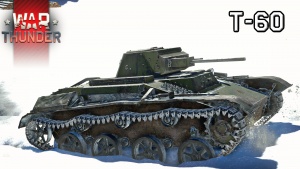
The armour of the T-60 is fairly effective frontally, being for the most part angled gives it good protection against similarly rated opponents with a high chance of causing shots to ricochet, however a shot to the side will likely be fatal due to the thin (15 mm) side armour and the vehicle only having a 2 man crew, this means that the loss of 1 crew member will cause the vehicle to be knocked out.
Armour type:
- Rolled homogeneous armour
| Armour | Front | Sides | Rear | Roof |
|---|---|---|---|---|
| Hull | 35 mm (24°) Driver's plate 15 mm (70°) Front glacis 35 mm (31°) Lower glacis |
15 mm | 10 mm (71°) Top 5 mm (71°) Radiator vent 25 mm (29°) Bottom |
15 mm (20°) Front glacis 20 mm Driver hatch 15 mm 5 mm Engine vent 10 mm (19°) Rear 5 mm (19°) Radiator vent |
| Turret | 25 mm (24°) Turret front 35 mm Gun mantlet |
25 mm (24-26°) | 25 mm (26°) | 10 mm Turret 20 mm Cupola |
Notes:
- Belly armour is 10 mm thick.
- Suspension wheels are 10 mm thick while tracks and torsion bars are 15 mm thick.
Mobility
| Game Mode | Max Speed (km/h) | Weight (tons) | Engine power (horsepower) | Power-to-weight ratio (hp/ton) | |||
|---|---|---|---|---|---|---|---|
| Forward | Reverse | Stock | Upgraded | Stock | Upgraded | ||
| Arcade | 50 | 7 | 5.8 | 118 | 134 | 20.34 | 23.1 |
| Realistic | 45 | 6 | 67 | 70 | 11.55 | 12.07 | |
The mobility of the T-60 is very comparable to the T-26, while it is fast enough to move around the map with ease, it is not mobile enough to be the first friendly to the cap or camping position, the mobility is enough to allow for a support or flanking role in most situations.
Modifications and economy
Armaments
Main armament
The main armament of the T-60 is a 20 mm TNSh cannon, this has a fire rate of 750 rounds/min and will have to reload after 58 rounds have been fired, the gun is certainly effective against lightly armoured opponents but will have trouble against higher-rated heavy and medium tanks.
| 20 mm TNSh | Turret rotation speed (°/s) | Reloading rate (seconds) | ||||||||||||
|---|---|---|---|---|---|---|---|---|---|---|---|---|---|---|
| Mode | Capacity (Belt) | Fire rate | Vertical | Horizontal | Stabilizer | Stock | Upgraded | Full | Expert | Aced | Stock | Full | Expert | Aced |
| Arcade | 754 (58) | 750 | -7°/+25° | ±180° | N/A | 14.30 | 19.76 | 24.00 | 26.54 | 28.24 | 26.00 | 23.00 | 21.20 | 20.00 |
| Realistic | 8.93 | 10.50 | 12.75 | 14.10 | 15.00 | |||||||||
Ammunition
- Default: AP-I · FI - The default belt is the most effective against aircraft because of the presence of 1/2 FI shells, which can make quick work of any aerial threats. Its performance against ground vehicles is however lessened by that.
- API: AP-I- This belt fixes the default belt's problem against ground vehicles, and allows you to have AP-I shells only. However, this reduces performance against aircraft.
- API HV: AP-I · AP-I · FI- This belt could be considered the best out of the three, as it has improved AP-I shells with a couple more millimetres of penetration. Additionally, the 1/3 FI shell presence helps with air defense quite a bit, but doesn't worsen your damage against ground vehicles as much as the default belt does.
| Penetration statistics | |||||||
|---|---|---|---|---|---|---|---|
| Ammunition | Penetration @ 0° Angle of Attack (mm) | ||||||
| 10 m | 100 m | 500 m | 1,000 m | 1,500 m | 2,000 m | ||
| FI | 3 | 3 | 2 | 2 | 2 | 2 | |
| API | 27 | 24 | 13 | 6 | 3 | 2 | |
| API HV | 32 | 28 | 15 | 7 | 3 | 2 | |
| Shell details | ||||||||||||
|---|---|---|---|---|---|---|---|---|---|---|---|---|
| Ammunition | Velocity (m/s) |
Projectile mass (kg) |
Fuse delay (m) |
Fuse sensitivity (mm) |
Explosive mass (TNT equivalent) (g) |
Ricochet | ||||||
| 0% | 50% | 100% | ||||||||||
| FI | 800 | 0.09 | 0.04 | 0.1 | 5.6 | 47° | 56° | 65° | ||||
| API | 800 | 0.1 | - | - | - | 47° | 56° | 65° | ||||
| API HV | 892 | 0.1 | - | - | - | 47° | 56° | 65° | ||||
Ammo racks
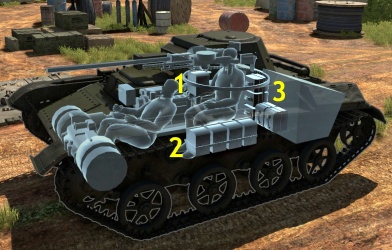
| Full ammo |
1st rack empty |
2nd rack empty |
3rd rack empty |
Visual discrepancy |
|---|---|---|---|---|
| 13 | 9 (+4) | 5 (+8) | 1 (+12) | Yes |
Note:
- 1 clip contains 58 rounds.
Machine guns
| 7.62 mm DT | ||||
|---|---|---|---|---|
| Mount | Capacity (Belt) | Fire rate | Vertical | Horizontal |
| Coaxial | 945 (63) | 600 | N/A | N/A |
Usage in battles
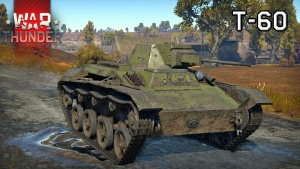
The T-60 is a fine little tank that excels in very particular situations; namely holding corners, flanking, and acting as a close range SPAA. This tank should never be used for long-range shooting or in pushes against an enemy head-on, one should always try to use its speed and manoeuvrability to gain an advantage before attacking. In a SPAA role, the long reload time for this tank's main weapon can be a severe disadvantage. This means that one should use controlled bursts when attacking aeroplanes, making all shots count, and only picking large slow moving targets when at the range. The presence of a co-axial machine gun, however, not only adds to the firing density but allows for the tank to fire whilst the cannon is reloading. This machine gun has no utility against armoured targets. In this role, the T-60 is the only SPAA in this rank that does not have to fear 7.7 mm rounds (although 12.7 mm rounds can be very deadly - the M2A2 is a very dangerous opponent, for instance). This means that T-60 pilots can be confident that they can survive being strafed by most fighter aircraft. In RB this tank serves as a perfectly capable replacement for the 4M GAZ-AAA. In conclusion, the T-60 is a versatile tank of good effectiveness that is a constant presence of any Rank I ground forces game. Its gun gives it easy penetration at the sides and some fronts of low-rank tanks.
This is a very versatile tank and that is its greatest strength. Its greatest weakness is it's horrible all around armour, always remember that you will probably not survive a single hit from an AT gun, and as such stay hidden and behind cover. In order to accomplish this use, this tanks great manoeuvrability to your advantage and try to hug cover and move in depressions of the landscape. When using this tank always attack from an unexpected angle then shot your entire belt and afterwards always re-position after an attack. A great strength of this tank is that at any point it can go from flanking an enemy tank to acting as a front line SPAA, and in many games this amazing ability that can save you and your comrades from certain death at the hands of an enemy bomber or attack plane.
Pros and cons
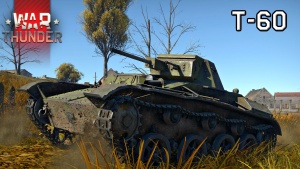
Pros:
- Sloped frontal armour
- Fast-firing gun, that can even harm aircraft due to calibre and rate of fire
- Good manoeuvrability
- Belts have a high ammunition count per belt
- Can act as a decent front line SPAA
- Low profile
- Often not regarded as a high priority target
Cons:
- Poor armour
- Very cramped interior
- Only 2 crew so you can't afford losing anyone
- Long reload time
- Very slow at climbing hills
- Retains speed bad
- Poor penetration values
- Poor post-penetration damage
History
Development
In 1938, a task to create an amphibious and non-amphibious scout tank was given to Nicholas Astrov's design team at Moscow Factory No. 37. The result was the T-30A and T-30B prototypes, with the A model being amphibious. The T-30A went on to become the T-40 amphibious scout tank, while the T-30B went on to become the T-60 scout tank. Production started on July 1941, one month after the German invasion in Operation Barbarossa.
Originally with a 12.7 mm machine gun, the T-60 was up-gunned with a 20 mm TNSh cannon, which was derived from an aircraft cannon. The gun could penetrate 15 mm of armour at a 500 m range, which proved very inadequate against the Germans Panzer IIIs and Panzer IVs, which had a maximum of 50 mm of armour on the front. Not only that, the scout tank had poor mobility on cross-country terrain and had a maximum armour of only 20 mm thick. Despite that, the T-60 was easily produced and 6,292 of these tanks were produced between 1941 and 1942.
Usage
The low gun performance urged for an attempt to upgrade the tank with a 37 mm ZIS-19 cannon or the standard 45 mm tank gun. Both of these projects were proven impossible. The T-60 served as a light tank up until the better T-70 light tank was chosen as the new standard Soviet light tank in 1942, which had better armour and gun.
The T-60 went on in armour developmental projects for the Soviet forces, such as the designing of the T-90 anti-aircraft vehicle. But perhaps the most unique project that it played in was the Antonov A-40, which was the Soviet's attempt on a "flying tank". The A-40 was a glider design that has wings attached to a lightened T-60 (removing its armament, ammunition, some accessories, and most of the fuel). On September 2, 1942, in a test, the prototype was towed by a TB-3 Bomber into the air. When released, the A-40 reportedly glided smoothly on its descent, despite the drag it put on the TB-3 plane. The A-40 landed safely and was able to drive back to the testing site after detaching the wings. The project was then abandoned due to the lack of enough aircraft with the power to tow the A-40 at 160 kilometres per hour speed.
The T-60 also were used by the Romanians when they captured 34 of them and modified them into the TACAM T-60 and Mareşal M05, both tank destroyers. All examples of these vehicles were confiscated by the Soviets after Romania switched to the Allies.
| Archive of the in-game description | |
|---|---|
|
The T-60 light tank was developed in August, 1941 at Moscow Factory #37 under the management of N.A. Astrov. In September, 1941 the T-60 was accepted into the arsenal of the Red Army and was released serially in several automobile factories. The T-60 was produced until February, 1943, when it was replaced on assembly lines by the more powerful T-70 light tank. A total of 5,920 T-60s were produced, 1,366 of them in 1941. Most of them were built at the Gorky Factory. Large numbers of T-60 tanks were used in battles from 1941 to 1943, starting with the Battle of Moscow and ending with the elimination of the Leningrad blockade in January, 1944. The T-60 was used actively throughout the Battle of Stalingrad and the Kharkov Operation. Due to significant losses, the T-60 was gradually removed from the front lines in late 1942. | |
Media
- Skins
See also
- Vehicles equipped with the same chassis
- Other vehicles of similar configuration and role
External links
Paste links to sources and external resources, such as:
- topic on the official game forum;
- other literature.
| USSR light tanks | |
|---|---|
| T-26 | T-26 · T-26 (1st Gv.T.Br.) · T-26-4 · T-26E |
| BT | BT-5 · RBT-5 · BT-7 · BT-7 TD · BT-7M · BT-7A (F-32) |
| T-50 | T-126 · T-50 |
| T-70 | T-70 · T-80 |
| PT-76 | PT-76B · PT-76-57 · Object 906 |
| BMP | BMP-1 · BMP-2 · BMP-2M · BMP-3 |
| BMD | BMD-4 |
| 2S25 | 2S25 · 2S25M |
| Wheeled | BA-11 · BTR-80A |
| Other | T-60 · Object 685 · 2S38 |
| China | ▂Type 62 |


